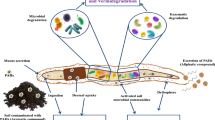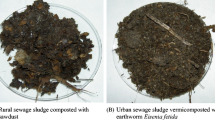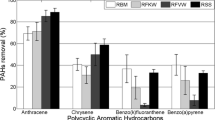Abstract
Knowledge on the mechanism of earthworm-induced removal of polycyclic aromatic hydrocarbons (PAH) in vermicomposting systems and interaction with nutrient mineralization and microbial growth is scarce in literature. Moreover, the PAH accumulation capacity of Eudrilus eugeniae has not been studied. This research, therefore, investigates the apportionment dynamics of 13 PAH compounds in aerobic composting and vermicomposting (Eisenia fetida and E. eugeniae) systems using novel budget equations. The PAH removal efficiency of vermicomposting was significantly higher (2–threefold) than composting with concurrent microbial augmentation (p < 0.01). However, the 4–6 ring compounds reduced more significantly (30–50%) than the 3-ring PAHs (p < 0.01), and E. eugeniae was an equally competitive PAH-accumulator compared to E. fetida. The budget equations revealed that although the bioaccumulation capabilities of earthworms were retarded due to PAH exposure, earthworms facilitated PAH-immobilization in decomposed feedstock. A marked increase in bacterial, fungal, and actinomycetes proliferation in PAH-spiked vermibeds with parallel removal of the PAHs indicated that earthworm-induced microbial enrichment plays a vital role in PAH detoxification during vermicomposting. Correlation analyses strongly implied that earthworm-driven mineralization-humification balancing and microbial enrichment could be the critical mechanism of PAH remediation under vermicomposting.



Similar content being viewed by others
Data availability
Data will be made available upon request.
References
Aemig Q, Doussiet N, Danel A et al (2019) Organic micropollutants’ distribution within sludge organic matter fractions explains their dynamic during sewage sludge anaerobic digestion followed by composting. Environ Sci Pollut Res 26:5820–5830. https://doi.org/10.1007/s11356-018-4014-7
Albogami B, Hodson M, Black S (2014) Application of Pb isotopes to track the sources and routes of metal uptake in the earthworm Eisenia fetida. Eurasian J Soil Sci 3:230–237. https://doi.org/10.18393/ejss.14486
Alef K (1995) Estimation of soil respiration. In: Alef K, Nannipieri P (eds) Methods in Applied Soil Microbiology and Biochemistry. Academic Press, London, UK
Amir S, Hafidi M, Merlina G et al (2005) Fate of polycyclic aromatic hydrocarbons during composting of lagooning sewage sludge. Chemosphere 58:449–458. https://doi.org/10.1016/j.chemosphere.2004.09.039
AOAC (1995) Official Methods of Analysis, 15th edn. Association of Official Agricultural Chemists. Washington D.C, USA
APHA (1998) Standard methods for the examination of water and wastewater, 20th edn. American Public Health Association, American Water Works Association and Water Environmental Federation, Washington DC, USA
Baboshin MA, Golovleva LA (2012) Biodegradation of polycyclic aromatic hydrocarbons (PAH) by aerobic bacteria and its kinetics aspects. Mikrobiologiia 81:695–706
Contreras-Ramos SM, Alvarez-Bernal D, Dendooven L (2006) Eisenia fetida increased removal of polycyclic aromatic hydrocarbons from soil. Environ Pollut 141:396–401. https://doi.org/10.1016/j.envpol.2005.08.057
Contreras-Ramos SM, Álvarez-Bernal D, Dendooven L (2008) Removal of polycyclic aromatic hydrocarbons from soil amended with biosolid or vermicompost in the presence of earthworms (Eisenia fetida). Soil Biol Biochem 40:1954–1959. https://doi.org/10.1016/j.soilbio.2008.04.009
Contreras-Ramos SM, Álvarez-Bernal D, Dendooven L (2009) Characteristics of earthworms (Eisenia fetida) in PAHs contaminated soil amended with sewage sludge or vermicompost. Appl Soil Ecol 41:269–276. https://doi.org/10.1016/j.apsoil.2008.11.008
Covino S, Fabianová T, Křesinová Z et al (2016) Polycyclic aromatic hydrocarbons degradation and microbial community shifts during co-composting of creosote-treated wood. J Hazard Mater 301:17–26. https://doi.org/10.1016/j.jhazmat.2015.08.023
Das S, Deka P, Goswami L et al (2016) Vermiremediation of toxic jute mill waste employing Metaphire posthuma. Environ Sci Pollut Res 23:15418–15431. https://doi.org/10.1007/s11356-016-6718-x
Das P, Barua S, Sarkar S et al (2018) Mechanism of toxicity and transformation of silver nanoparticles: Inclusive assessment in earthworm-microbe-soil-plant system. Geoderma 314:73–84. https://doi.org/10.1016/j.geoderma.2017.11.008
Dendooven L, Alvarez-Bernal D, contreras-Ramos S (2011) Earthworms, a means to accelerate removal of hydrocarbons (PAHs) from soil? A mini-review. Pedobiologia (Jena) 54. https://doi.org/10.1016/j.pedobi.2011.08.006
Devi J, Deb U, Barman S et al (2020) Appraisal of lignocellusoic biomass degrading potential of three earthworm species using vermireactor mediated with spent mushroom substrate: Compost quality, crystallinity, and microbial community structural analysis. Sci Total Environ 716:135215. https://doi.org/10.1016/j.scitotenv.2019.135215
Eijsackers H (2010) Earthworms as colonisers: primary colonisation of contaminated land, and sediment and soil waste deposits. Sci Total Environ 408:1759–1769. https://doi.org/10.1016/j.scitotenv.2009.12.046
Epstein E (1997) The Science of Composting. Technomic Publishing Co., Ltd, Lancaster, USA
Esmaeili A, Knox O, Juhasz A, Wilson SC (2022) Differential accumulation of polycyclic aromatic hydrocarbons (PAHs) in three earthworm ecotypes: Implications for exposure assessment on historically contaminated soils. Environ Adv 7:100175. https://doi.org/10.1016/j.envadv.2022.100175
Furlong C, Rajapaksha NS, Butt KR, Gibson WT (2017) Is composting worm availability the main barrier to large-scale adoption of worm-based organic waste processing technologies? J Clean Prod 164:1026–1033. https://doi.org/10.1016/j.jclepro.2017.06.226
Geissen V, Gomez-Rivera P, Huerta Lwanga E et al (2008) Using earthworms to test the efficiency of remediation of oil-polluted soil in tropical Mexico. Ecotoxicol Environ Saf 71:638–642. https://doi.org/10.1016/j.ecoenv.2008.02.015
Goswami L, Mukhopadhyay R, Bhattacharya SS et al (2018) Detoxification of chromium-rich tannery industry sludge by Eudrillus eugeniae: Insight on compost quality fortification and microbial enrichment. Bioresour Technol 266:472–481. https://doi.org/10.1016/j.biortech.2018.07.001
Guo Y, Laux SJ, Burdier M et al (2020a) Polycyclic aromatic hydrocarbons in processed yard trash. Waste Manag Res 38:825–830. https://doi.org/10.1177/0734242X20925154
Guo Y, Rene ER, Wang J, Ma W (2020b) Biodegradation of polyaromatic hydrocarbons and the influence of environmental factors during the co-composting of sewage sludge and green forest waste. Bioresour Technol 297:122434. https://doi.org/10.1016/j.biortech.2019.122434
Hafidi M, Amir S, Jouraiphy A et al (2008) Fate of polycyclic aromatic hydrocarbons during composting of activated sewage sludge with green waste. Bioresour Technol 99:8819–8823. https://doi.org/10.1016/j.biortech.2008.04.044
Hussain N, Das S, Goswami L et al (2018) Intensification of vermitechnology for kitchen vegetable waste and paddy straw employing earthworm consortium: assessment of maturity time, microbial community structure, and economic benefit. J Clean Prod 182:414–426. https://doi.org/10.1016/j.jclepro.2018.01.241
Infante-Rodríguez DA, Berber JJ, Mercado G et al (2016) Earthworm mediated dispersal of baculovirus occlusion bodies: Experimental evidence from a model system. Biol Control 100:18–24. https://doi.org/10.1016/j.biocontrol.2016.05.005
Khwairakpam M, Bhargava R (2009) Bioconversion of filter mud using vermicomposting employing two exotic and one local earthworm species. Bioresour Technol 100:5846–5852. https://doi.org/10.1016/j.biortech.2009.06.038
Kriipsalu M, Marques M, Hogland W, Nammari DR (2008) Fate of polycyclic aromatic hydrocarbons during composting of oily sludge. Environ Technol 29:43–53. https://doi.org/10.1080/09593330802008735
Ma WC, Immerzeel J, Bodt J (1995) Earthworm and food interactions on bioaccumulation and disappearance in soil of polycyclic aromatic hydrocarbons: studies on phenanthrene and fluoranthene. Ecotoxicol Environ Saf 32:226–232. https://doi.org/10.1006/eesa.1995.1108
Mattei P, Cincinelli A, Martellini T et al (2016) Reclamation of river dredged sediments polluted by PAHs by co-composting with green waste. Sci Total Environ 566–567:567–574. https://doi.org/10.1016/j.scitotenv.2016.05.140
Mojiri A, Zhou JL, Ohashi A et al (2019) Comprehensive review of polycyclic aromatic hydrocarbons in water sources, their effects and treatments. Sci Total Environ 696:133971. https://doi.org/10.1016/j.scitotenv.2019.133971
Mondal A, Goswami L, Hussain N et al (2020) Detoxification and eco-friendly recycling of brick kiln coal ash using Eisenia fetida: a clean approach through vermitechnology. Chemosphere 244:125470. https://doi.org/10.1016/j.chemosphere.2019.125470
Nelson DW, Sommers LE (1996) Total Carbon, Organic Carbon, and Organic Matter. Methods of Soil Analysis Part 3—Chemical Methods. Soil Science Society of America. American Society of Agronomy, Madison, WI, pp 961–1010
Nie Lim P, Yeong WuT, Yih Shyang Sim E, Lin Lim S (2011) The potential reuse of soybean husk as feedstock of Eudrilus eugeniae in vermicomposting. J Sci Food Agric 91:2637–2642. https://doi.org/10.1002/jsfa.4504
Olsen SR (1954) Estimation of available phosphorus in soils by extraction with sodium bicarbonate. USDA, Washington D.C., USA
Panse VG, Sukhatme PV (1954) Statistical methods for agricultural workers. Statistical methods for agricultural workers, 2nd edn. Indian Council of Agricultural Research, New Delhi, India
Patel AB, Shaikh S, Jain KR et al (2020) Polycyclic aromatic hydrocarbons: sources, toxicity, and remediation approaches. Front Microbiol 11. https://doi.org/10.3389/fmicb.2020.562813
Paul S, Goswami L, Pegu R, Sundar Bhattacharya S (2020) Vermiremediation of cotton textile sludge by Eudrilus eugeniae: Insight into metal budgeting, chromium speciation, and humic substance interactions. Bioresour Technol 314:123753. https://doi.org/10.1016/j.biortech.2020.123753
Paul S, Goswami L, Pegu R et al (2022) Epigenetic regulations enhance adaptability and valorization efficiency in Eisenia fetida and Eudrilus eugeniae during vermicomposting of textile sludge: Insights on repair mechanisms of metal-induced genetic damage and oxidative stress. Bioresour Technol 345:126493. https://doi.org/10.1016/j.biortech.2021.126493
Peng J-J, Liu B, Xu J-Y et al (2017) NADPH oxidase: its potential role in promotion of pulmonary arterial hypertension. Naunyn Schmiedebergs Arch Pharmacol 390:331–338. https://doi.org/10.1007/s00210-017-1359-2
Poluszyńska J, Jarosz-Krzemińska E, Helios-Rybicka E (2017) Studying the Effects of Two Various Methods of Composting on the Degradation Levels of Polycyclic Aromatic Hydrocarbons (PAHs) in Sewage Sludge. Water Air Soil Pollut 228:305. https://doi.org/10.1007/s11270-017-3481-7
Pramer D, Schmidt EL (1964) Experimental soil microbiology. Soil Sci 98. https://doi.org/10.1097/00010694-196409000-00026
Rodriguez-Campos J, Dendooven L, Alvarez-Bernal D, Contreras-Ramos SM (2014) Potential of earthworms to accelerate removal of organic contaminants from soil: A review. Appl Soil Ecol 79:10–25. https://doi.org/10.1016/j.apsoil.2014.02.010
Rorat A, Wloka D, Grobelak A et al (2017) Vermiremediation of polycyclic aromatic hydrocarbons and heavy metals in sewage sludge composting process. J Environ Manag 187:347–353. https://doi.org/10.1016/j.jenvman.2016.10.062
Roy S, Sarkar D, Datta R et al (2022) Assessing the arsenic-saturated biochar recycling potential of vermitechnology: Insights on nutrient recovery, metal benignity, and microbial activity. Chemosphere 286:131660. https://doi.org/10.1016/j.chemosphere.2021.131660
Rusinowski S, Szada-Borzyszkowska A, Zieleźnik-Rusinowska P et al (2019) How autochthonous microorganisms influence physiological status of Zea mays L. cultivated on heavy metal contaminated soils? Environ Sci Pollut Res 26:4746–4763. https://doi.org/10.1007/s11356-018-3923-9
Sahariah B, Goswami L, Kim K-H et al (2015) Metal remediation and biodegradation potential of earthworm species on municipal solid waste: A parallel analysis between Metaphire posthuma and Eisenia fetida. Bioresour Technol 180:230–236. https://doi.org/10.1016/j.biortech.2014.12.062
Sahariah B, Das S, Goswami L et al (2020) An avenue for replacement of chemical fertilization under rice-rice cropping pattern: Sustaining soil health and organic C pool via MSW-based vermicomposts. Arch Agron Soil Sci 66:1449–1465. https://doi.org/10.1080/03650340.2019.1679782
Sayara T, Sánchez A (2020) Bioremediation of PAH-contaminated soils: process enhancement through composting/compost. Appl Sci 10. https://doi.org/10.3390/app10113684
Sisinno CLS, Pereira Netto AD, do Rego ECP, dos Lima GS (2003) Polycyclic aromatic hydrocarbons in industrial solid waste: a preliminary evaluation of the potential risk of environmental and human contamination in waste disposal areas. Cad Saude Publica 19:671–676. https://doi.org/10.1590/s0102-311x2003000200035
SSSA (2022) Quality Assurance and Quality Control (QA/QC) Manual Recommendations, 2nd edn. Soil Science Society of America, Provo. https://www.naptprogram.org/methods/
Tejada M, Masciandaro G (2011) Application of organic wastes on a benzo(a)pyrene polluted soil. Response of soil biochemical properties and role of Eisenia fetida. Ecotoxicol Environ Saf 74:668–674. https://doi.org/10.1016/j.ecoenv.2010.10.018
Vance ED, Brookes PC, Jenkinson DS (1987) An extraction method for measuring soil microbial biomass C. Soil Biol Biochem 19(6):703–707. https://doi.org/10.1016/0038-0717(87)90052-6
Veeken AHM, Hamelers HVM (1999) Removal of heavy metals from sewage sludge by extraction with organic acids. Water Sci Technol 40:129–136. https://doi.org/10.1016/S0273-1223(99)00373-X
Wågman N, Strandberg B, Tysklind M (2001) Dietary uptake and elimination of selected polychlorinated biphenyl congeners and hexachlorobenzene in earthworms. Environ Toxicol Chem 20:1778–1784. https://doi.org/10.1897/1551-5028(2001)020%3c1778:duaeos%3e2.0.co;2
Wang S-W, Hsu K-H, Huang S-C et al (2019) Determination of polycyclic aromatic hydrocarbons (PAHs) in cosmetic products by gas chromatography-tandem mass spectrometry. J Food Drug Anal 27:815–824. https://doi.org/10.1016/j.jfda.2019.01.003
Wheatley AD, Sadhra S (2004) Polycyclic aromatic hydrocarbons in solid residues from waste incineration. Chemosphere 55:743–749. https://doi.org/10.1016/j.chemosphere.2003.10.055
Xia W, Liang B, Chen L et al (2022) Atmospheric wet and dry depositions of polycyclic aromatic compounds in a megacity of Southwest China. Environ Res 204:112151. https://doi.org/10.1016/j.envres.2021.112151
Xiao R, Ali A, Xu Y et al (2022) Earthworms as candidates for remediation of potentially toxic elements contaminated soils and mitigating the environmental and human health risks: A review. Environ Int 158:106924. https://doi.org/10.1016/j.envint.2021.106924
Acknowledgements
All authors acknowledge the help extended by their respective affiliating organizations in terms of research infrastructure and administrative support.
Funding
No funds, grants, or other support was received.
Author information
Authors and Affiliations
Contributions
JD and HM conducted the experiment, analyzed the data, and wrote the first draft. NG wrote the manuscript and discussed the results. SD made the graphics, edited, and formatted the manuscript. PC supervised the HPLC analyses and discussed the results. SSB conceptualized and supervised the entire work, wrote, reviewed, and edited the manuscript.
Corresponding author
Ethics declarations
Ethical approval
Not applicable.
Consent to participate
Not applicable.
Consent to publish
Not applicable.
Competing interests
All authors certify that they have no affiliations with or involvement in any organization or entity with any financial interest or non-financial interest in the subject matter or materials discussed in this manuscript.
Additional information
Responsible Editor: Chris Lowe
Publisher's Note
Springer Nature remains neutral with regard to jurisdictional claims in published maps and institutional affiliations.
Supplementary Information
Below is the link to the electronic supplementary material.
Rights and permissions
Springer Nature or its licensor (e.g. a society or other partner) holds exclusive rights to this article under a publishing agreement with the author(s) or other rightsholder(s); author self-archiving of the accepted manuscript version of this article is solely governed by the terms of such publishing agreement and applicable law.
About this article
Cite this article
Devi, J., Mandal, H., Das, S. et al. Polycyclic aromatic hydrocarbon (PAH) remediation during vermicomposting and composting: Mechanistic insights through PAH-budgeting. Environ Sci Pollut Res 30, 105202–105219 (2023). https://doi.org/10.1007/s11356-023-29705-0
Received:
Accepted:
Published:
Issue Date:
DOI: https://doi.org/10.1007/s11356-023-29705-0




